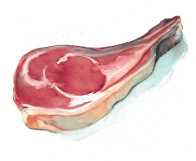Down and Out in Paris and London
RIB-EYE STEAK

When I started working in restaurants as a student at NYU, I assumed that my two lives—my life studying English and Latin, and my life making and serving food—would be totally separate. I never expected that so much of my time in the kitchen would be spent talking to my coworkers about literature. Kitchens are physical places, and all of the chopping, sweating, tasting, poking, and bumping into each other naturally leads to a lot of bawdy, mindless chatter. In between all of the nasty jokes and posturing, though, in the quiet, reflective moments that kitchen work can also bring, we talked about books.
Of all the books I talked about in kitchens over the years, the one that came up most often was George Orwell’s Down and Out in Paris and London. I had read 1984 and Animal Farm in high school, neither of which was particularly life-altering for me, but when Morgan, one of my favorite cooks, told me that Down and Out was the reason he first decided to set foot in a professional kitchen, I finally sat down and read it.
The thought of someone pursuing kitchen work because of this book still baffles me (Orwell’s account of his backbreaking eighteen-hour days for pitiable pay is nearly unbearable at times), but I can certainly understand why someone accustomed to working in kitchens would love it. Orwell’s descriptions of the frantic exhilaration of a dinner rush, of the feeling of emerging from the hatch into the cool night air after a fourteen-hour shift, of the camaraderie that exists between unlikely people in a kitchen and the satisfaction of a post–dinner service drink—these are all spot on. Orwell is young and hungry, and like so many of the people I’ve worked with over the years, he is cooking as a way to get by, and loving it.
One of the things that surprised me most when I first started cooking was the sheer amount of touching and shaping and tasting that goes into creating a dish. Even in the cleanest kitchens, I never worked with a chef who wore gloves. Chefs dip their tasting spoons into sauces more than once, they arrange the greens with their bare hands, they tidy the dots of sauce around the plate with their thumbs—it’s very intimate. The kitchens Orwell was working in, and the cooks he was working with, were filthy, which makes the idea of this hands-on treatment slightly more stomach-turning, but the sentiment is still the same: “Food, to look smart, needs dirty treatment.… Roughly speaking, the more one pays for food, the more sweat and spittle one is obliged to eat with it.”
According to Orwell, steak, which is often the most expensive item on a menu, is also among the most poked and prodded. In his experience, when a steak is brought to the head chef to be inspected before getting sent out, the chef “does not handle it with a fork. He picks it up in his fingers and slaps it down, runs his thumb round the dish and licks it to taste the gravy, runs it round and licks again.” Right before the waiter comes for pickup, the chef gives the steak one final loving poke “with his fat, pink fingers, every one of which he has licked a hundred times that morning.”
On a cooking line, the role of protein cook is highly regarded and is usually reserved for either the head chef or the head line cook. I think the same rule applies in a lot of home kitchens—the most skilled cook handles the meat—because there is a notion that it is the biggest, scariest, and most important job. From working at a butcher shop I’ve learned that a lot people are absolutely terrified of cooking meat. My coworkers and I spend a good amount of time talking people down from their pre–dinner party, picky-guest, former-vegan ledges, writing step-by-step directions in Sharpie on their paper-wrapped cuts of meat, seasoning their steaks, assuring them that they will have enough and that it will be delicious.
I’m not sure if it’s the size, or the bone, or the price, but the steak that seems to terrify customers the most is the bone-in rib-eye, which also happens to be my favorite cut. I hope you’ll let me take the fear out of the rib-eye for you. You don’t even need a grill. The only tools you need are a well-seasoned cast-iron skillet and a meat thermometer.
DOWN AND OUT IN PARIS AND LONDON
Rib-Eye Steak
Serves 2
1 (1½-pound) bone-in rib-eye steak, cut 1½ inches thick
Kosher salt
2 tablespoons high-smoke-point neutral oil, such as grapeseed oil
1 tablespoon unsalted butter
Pat the steak dry with a paper towel and leave it on the counter to sit out at room temp for 30 to 45 minutes prior to cooking. About 10 minutes before you’re ready to cook, season the steak liberally on both sides with salt and pepper.
Heat the oil in a cast-iron skillet over medium-high heat until it just begins to smoke. Add the steak and cook until the surface has a good crusty sear, 6 to 8 minutes per side. For a steak cooked to just shy of medium (which is what I recommend for a rib-eye), the internal temperature should reach 135°F; the temperature will come up about 5 degrees while the steak is resting. Transfer the steak to a cutting board, put the butter on top to melt, and tent it with foil. Let the steak rest for about 10 minutes before slicing it against the grain and serving.